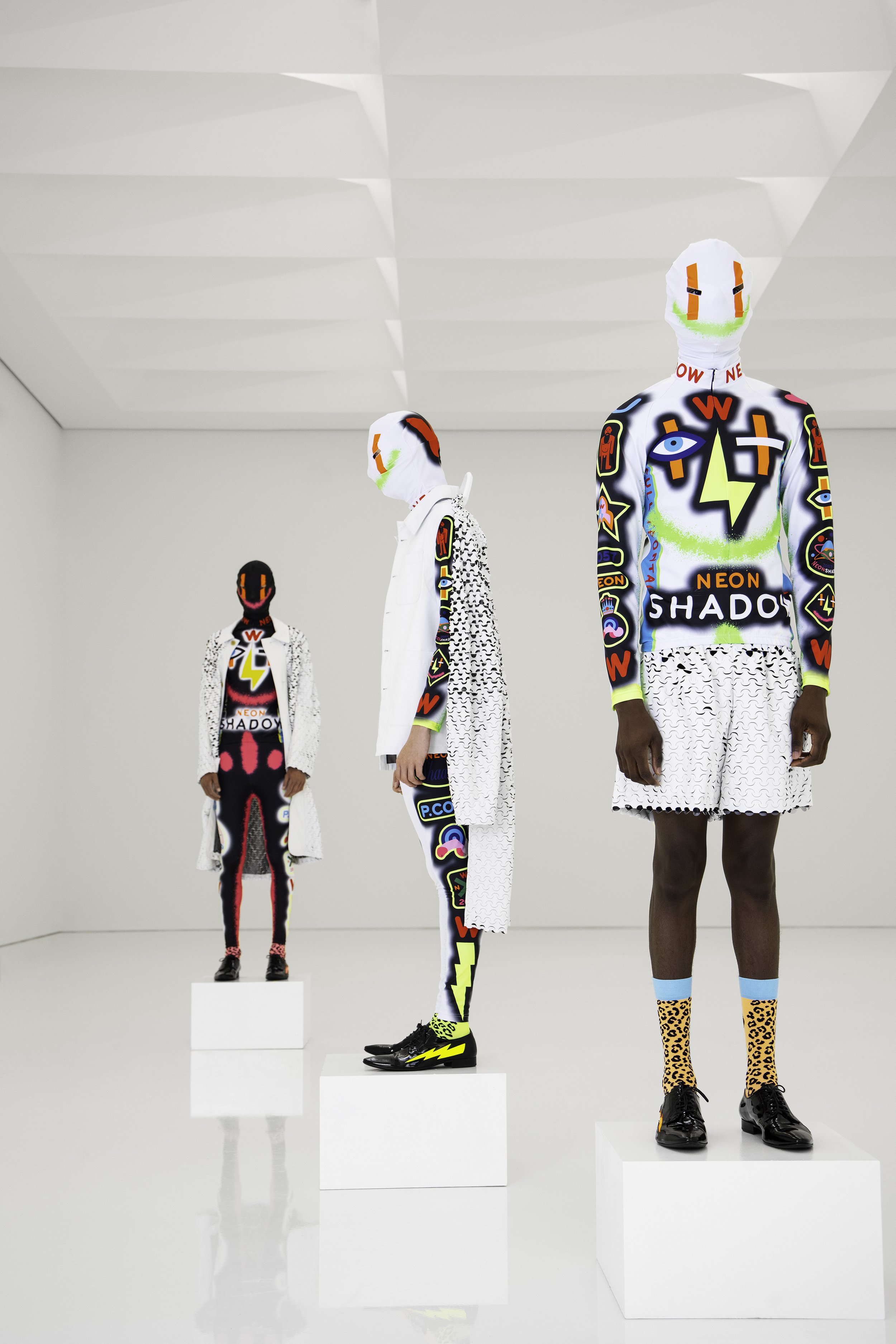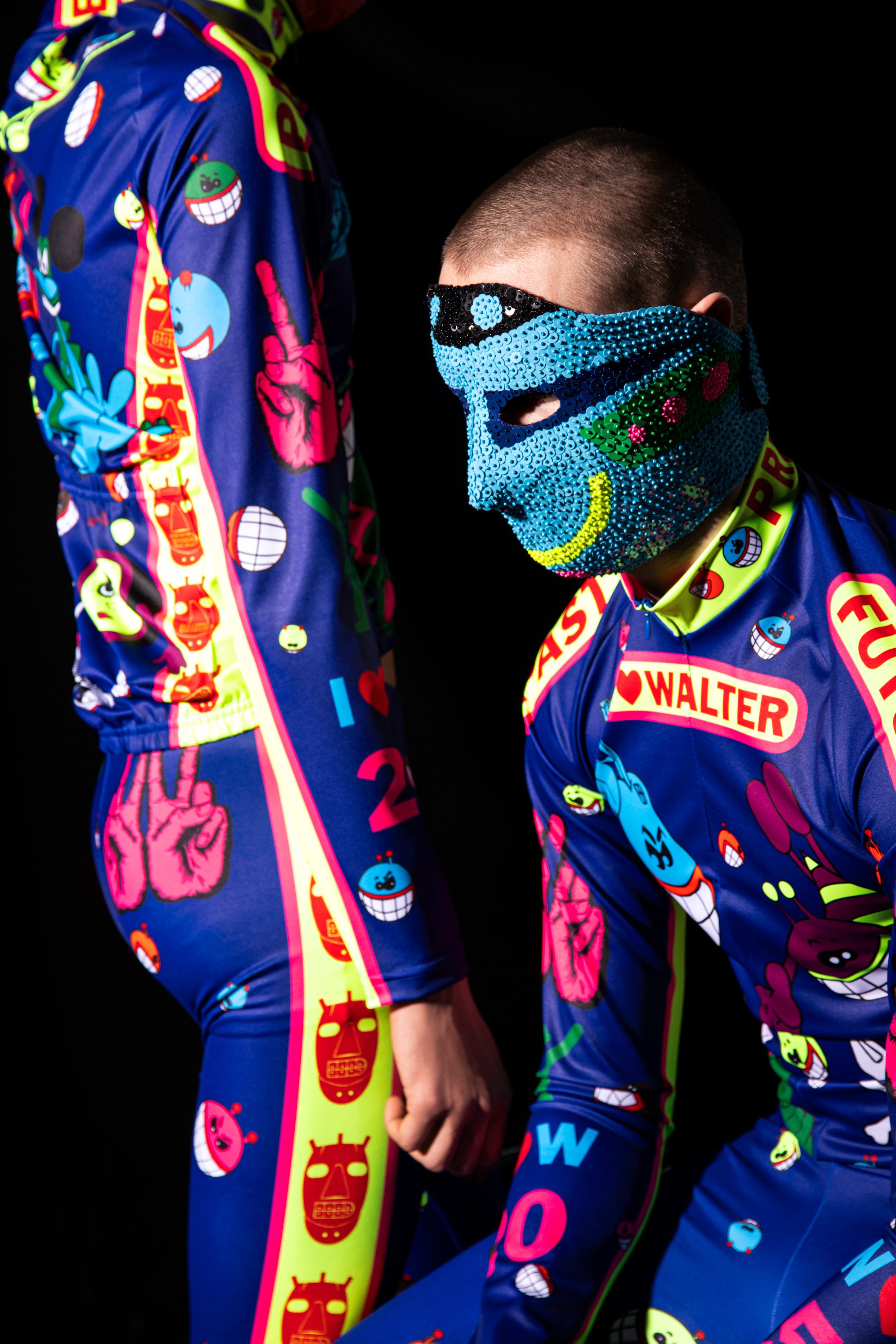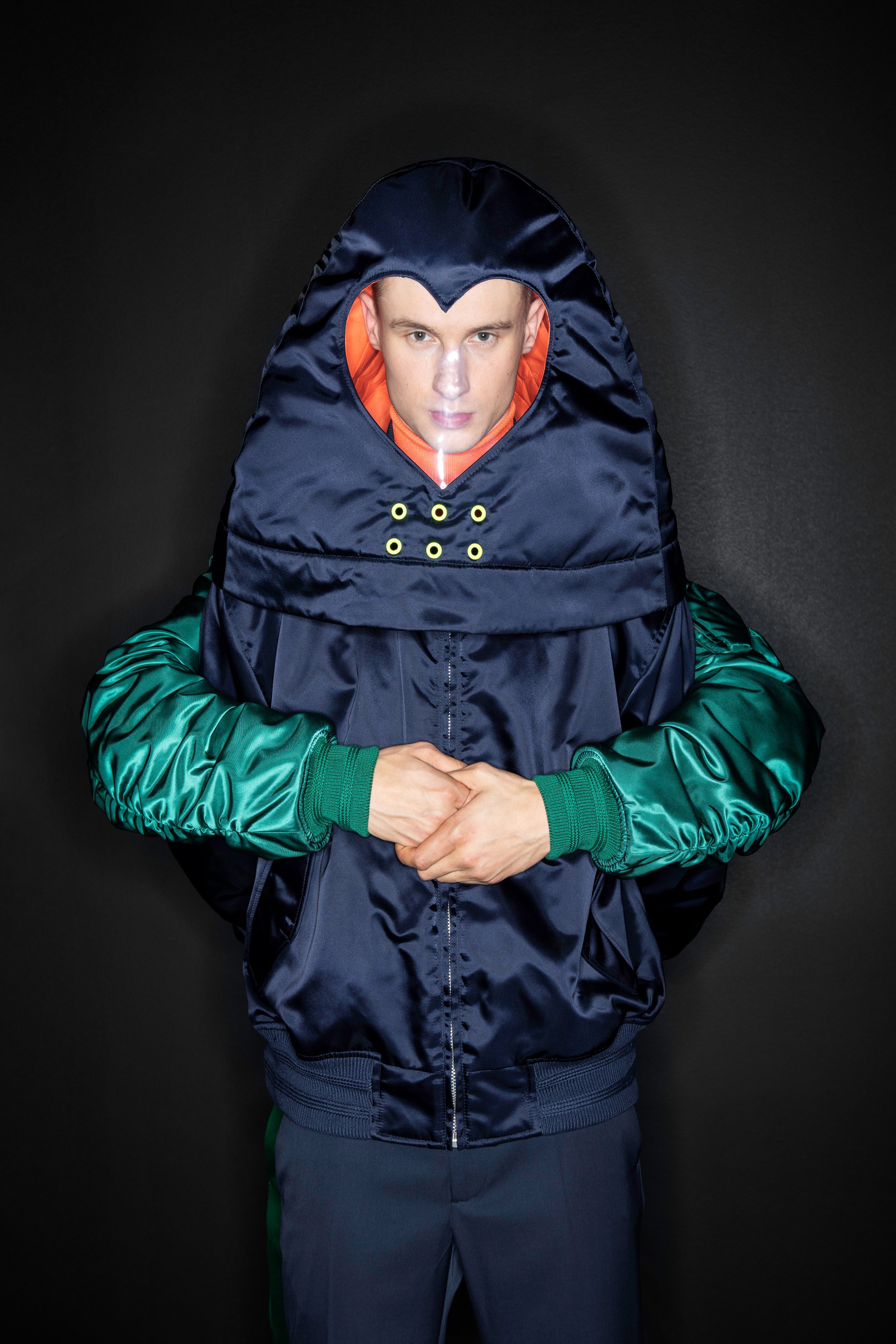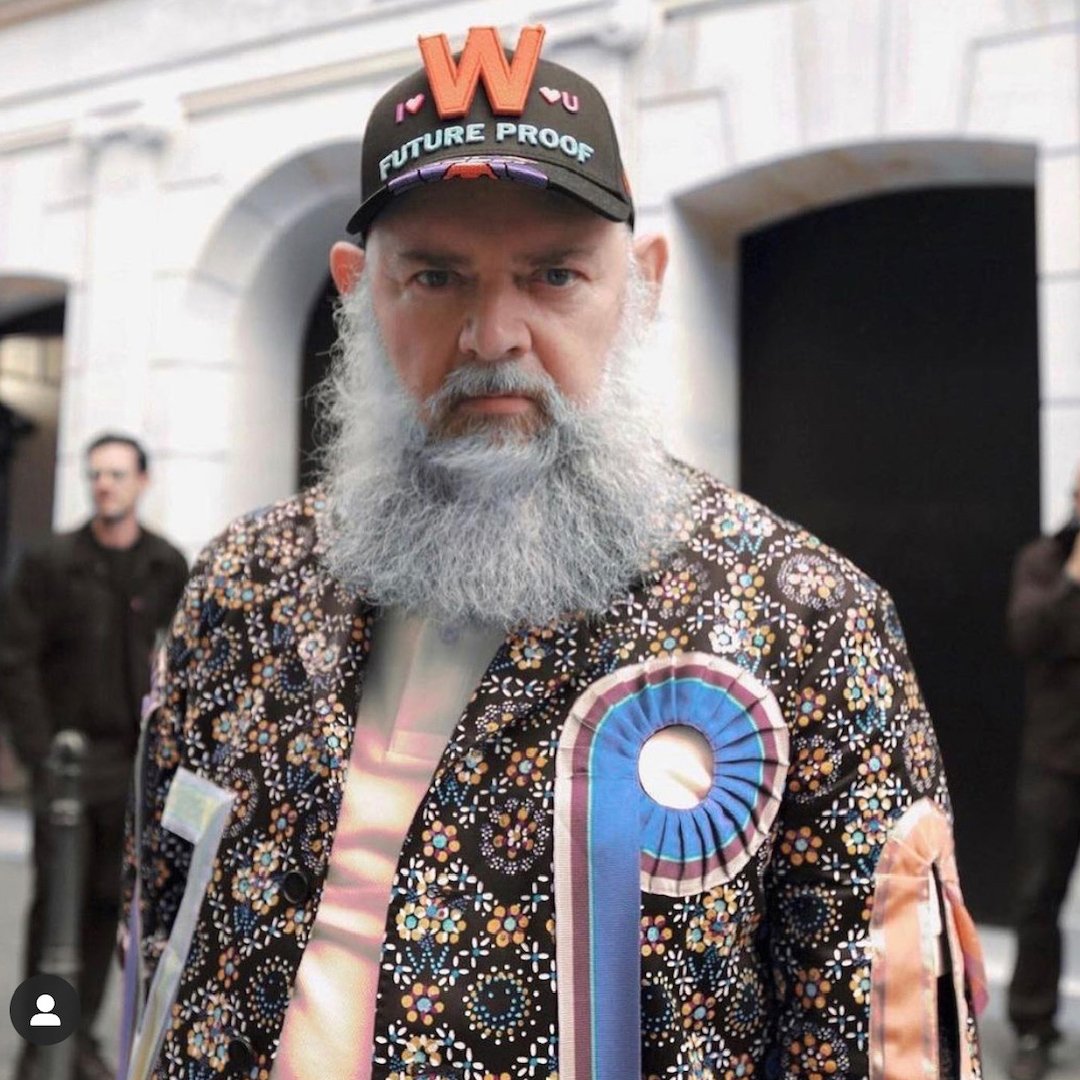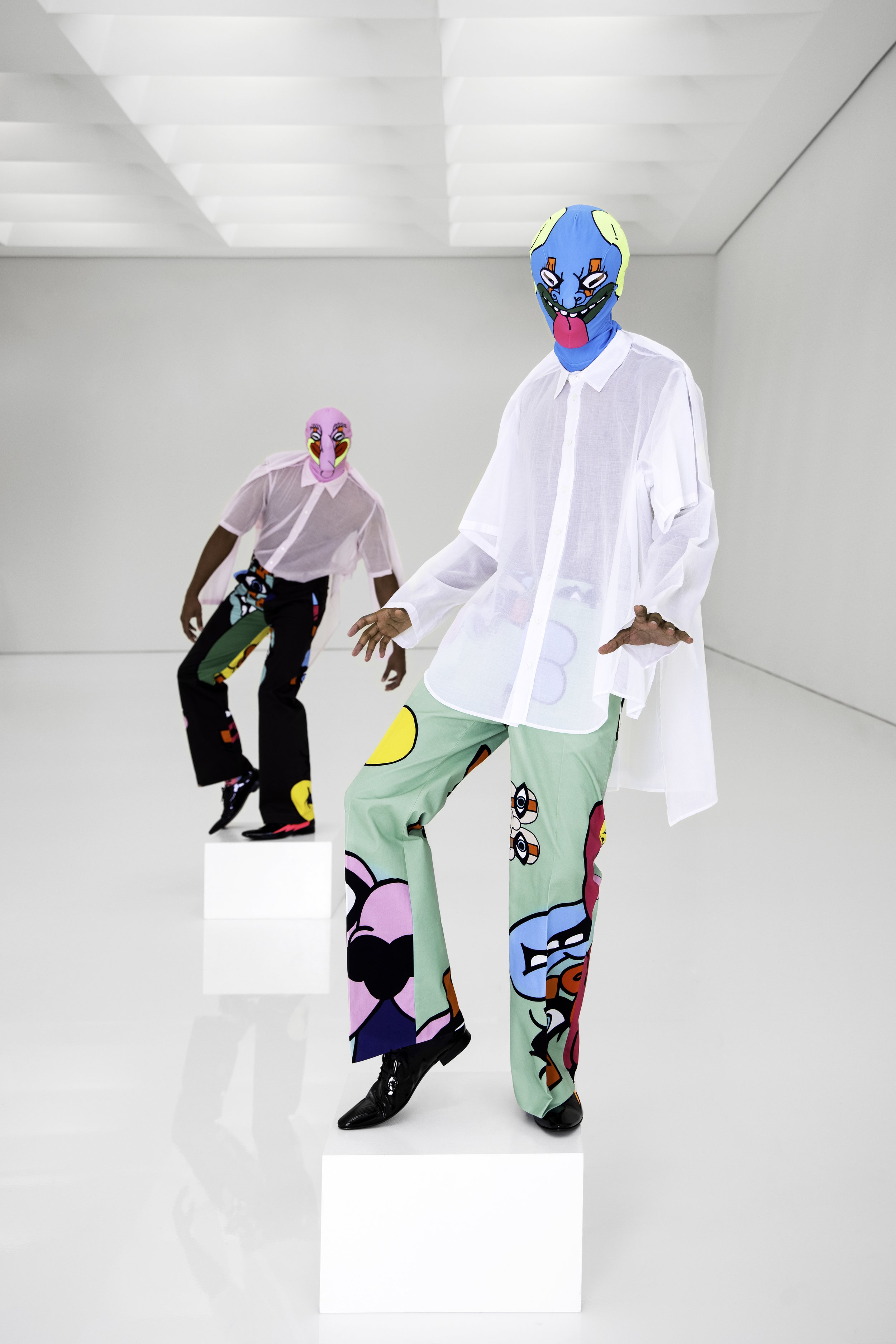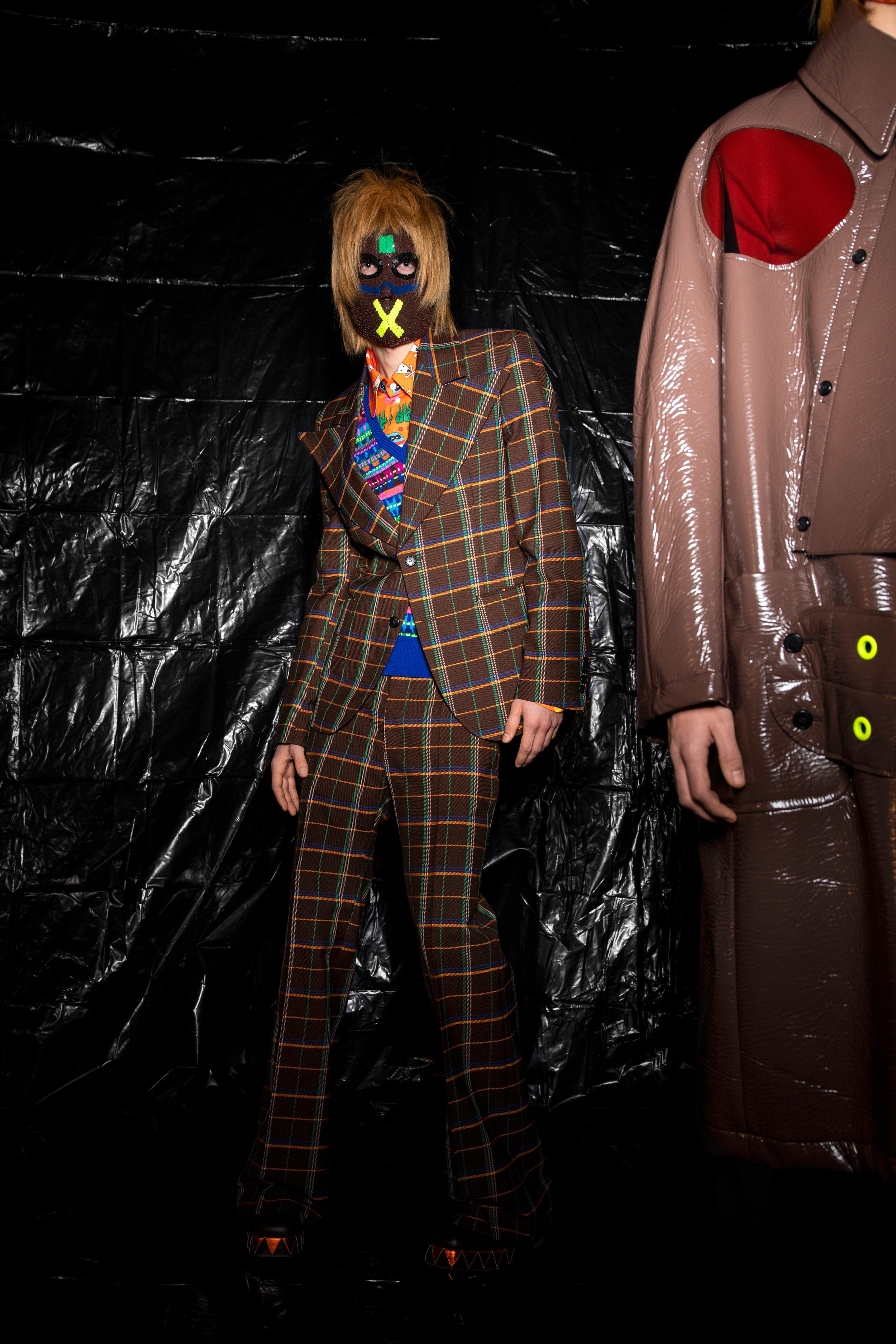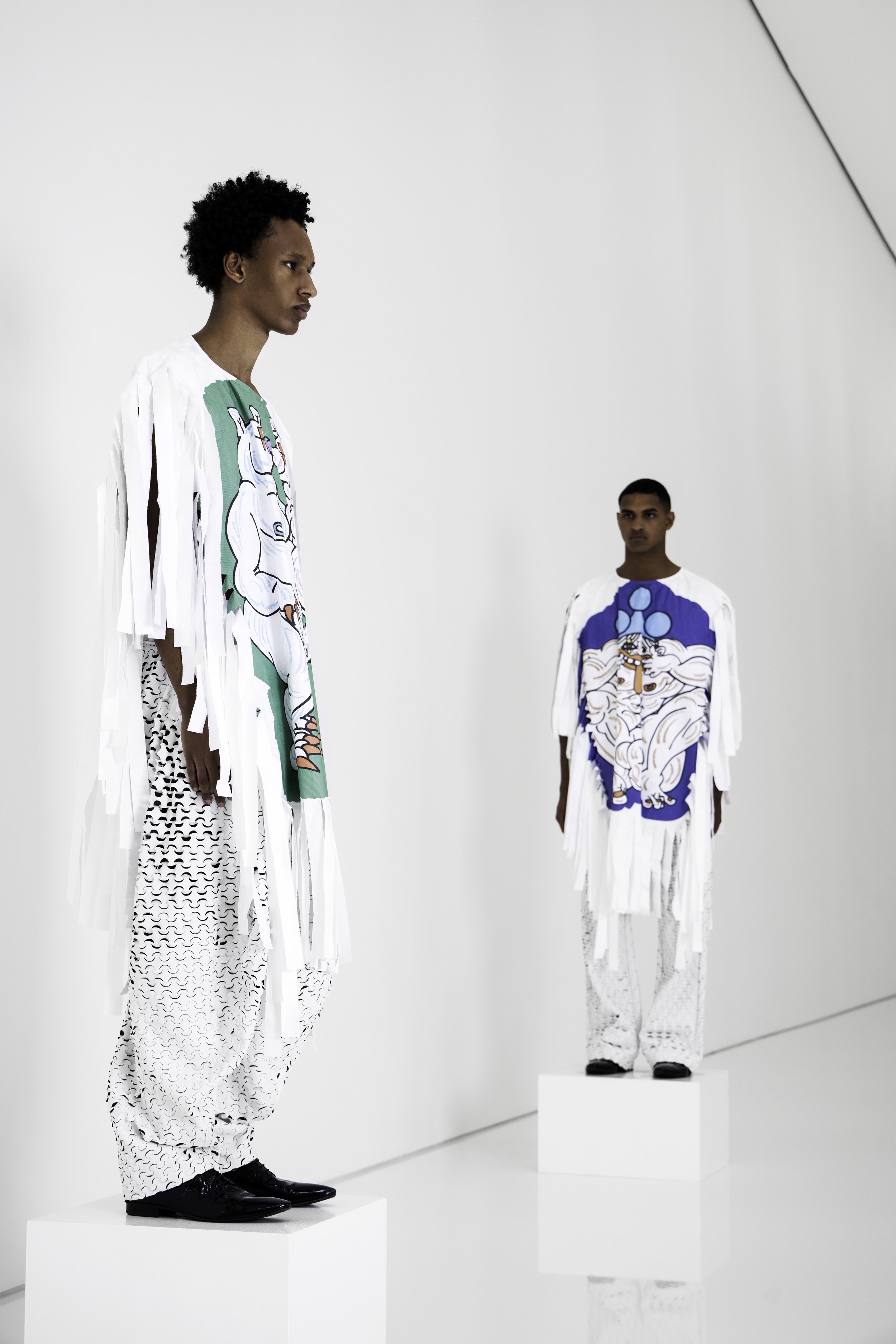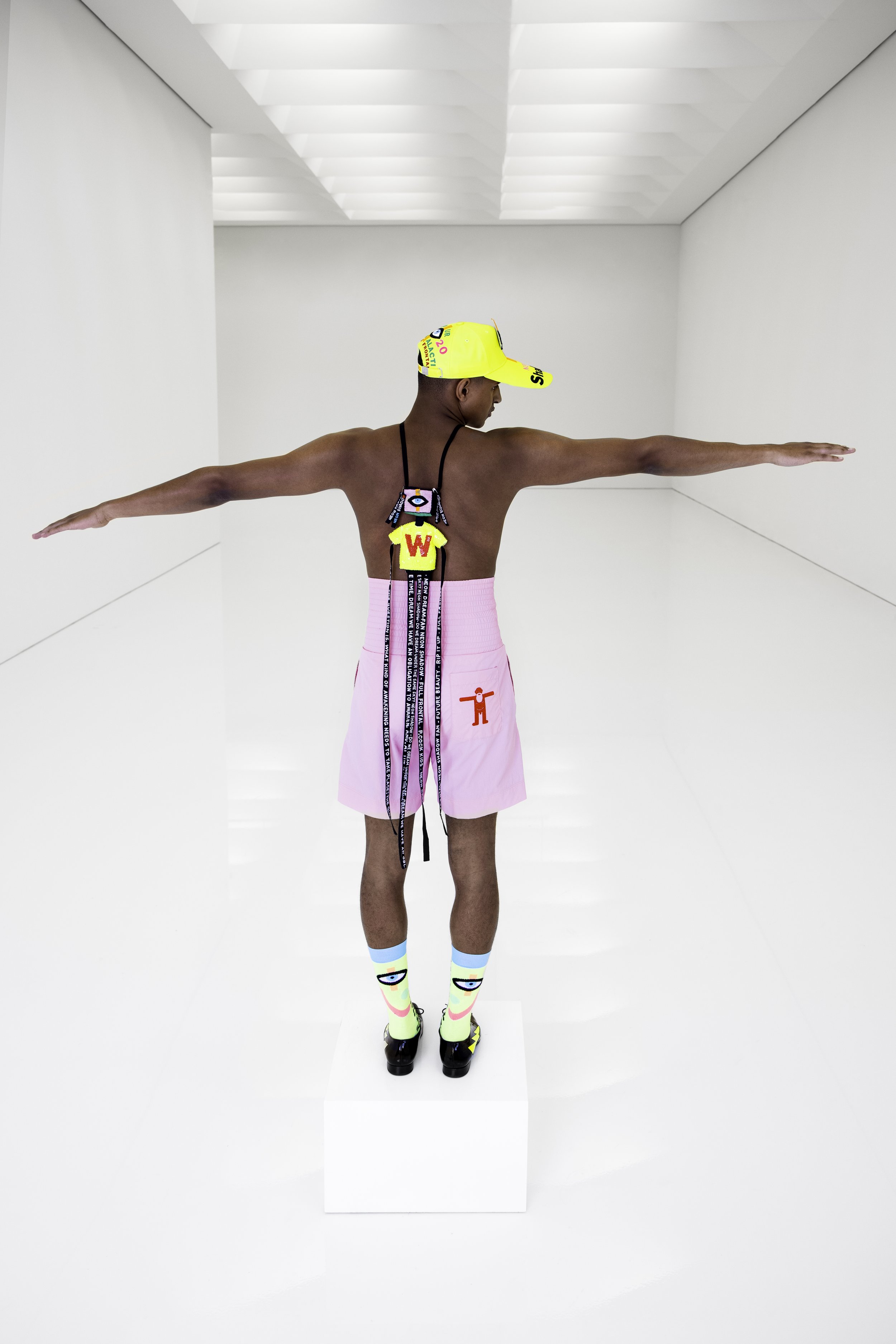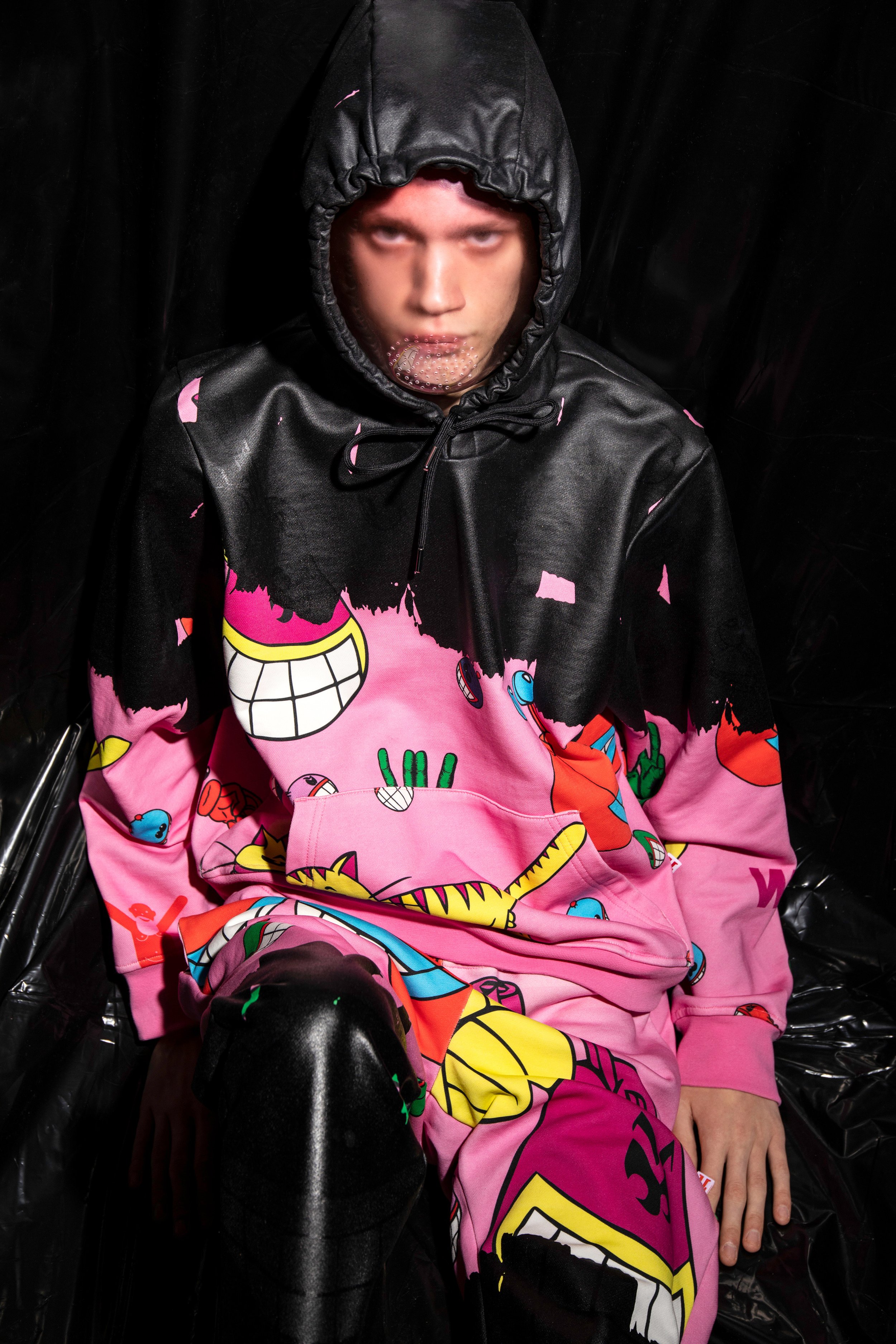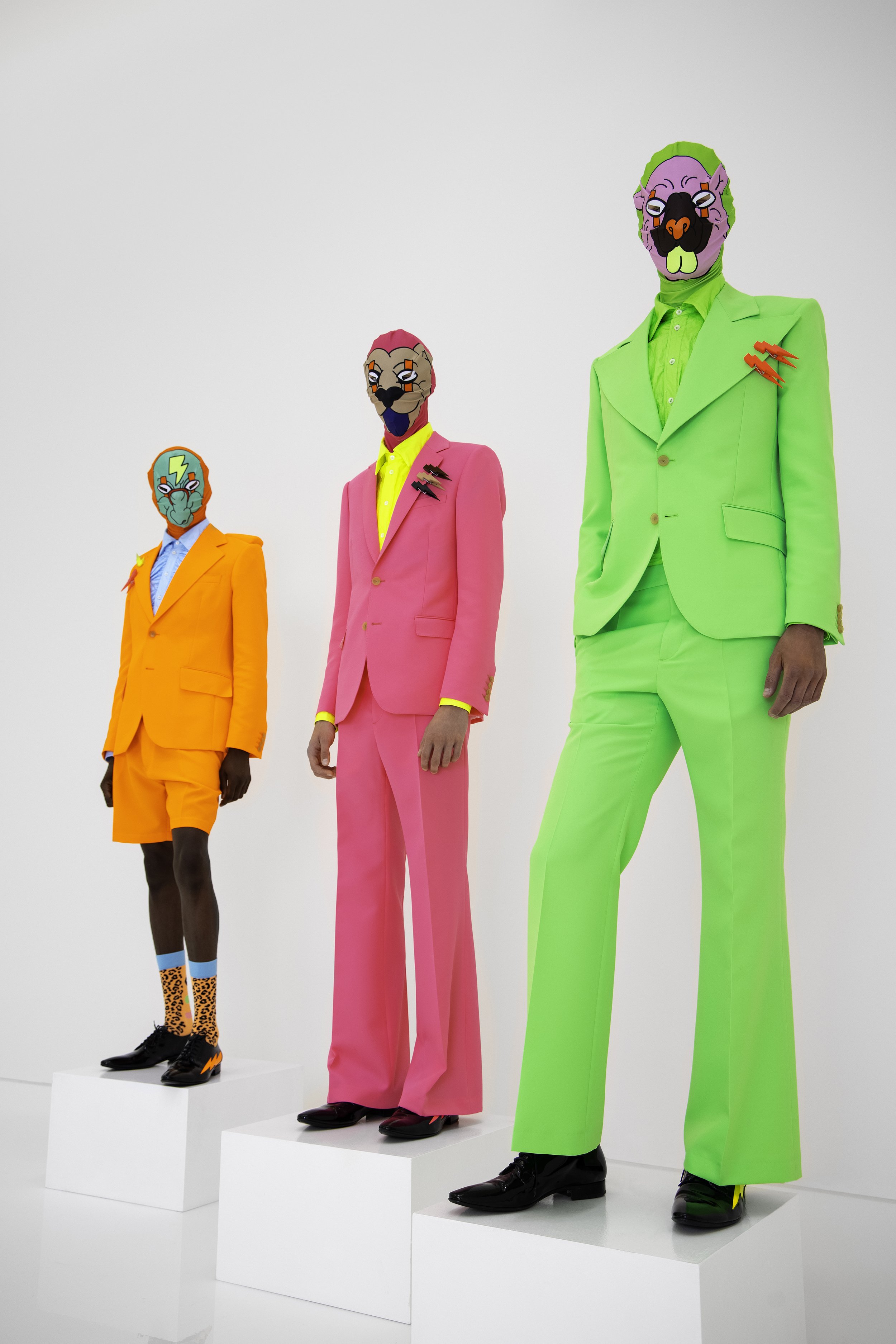
Walter Van Beirendonck
WVB SS22 Look 1
Walter Van Beirendonck is an independent designer, curator and director of fashion at the Royal Academy of Fine Arts in Antwerp, Belgium. Since 1983 his collections have disrupted conventions around menswear, gender identity and ideas of beauty. He is a member of the highly influential group, Antwerp Six +1 that includes, Ann Demeulemeester, Dirk Van Saene, Dries Van Noten, Dirk Bikkembergs, Marina Yee and Martin Margiela. Awarded the honor of Ambassador for Flanders in 1999, he has collaborated on projects for ballet, theatre and film, as well as exhibitions worldwide. Talented fashion designers who have emerged under his tutelage include Bernhard Willhelm, Raf Simons and Demna Gvasalia, the current creative director of Balenciaga.
Interview by Sascha Behrendt
You are considered the biggest innovator in menswear fashion. Did you ever desire to design women’s wear?
Thank you for the compliment. It is much appreciated! I concentrated early on with men’s fashion as I found it much more challenging and adventurous to design. The first collection I presented internationally was, "BAD BABY BOYS.”
I enjoy pushing the boundaries of men’s fashion and 90% of my collections are worn on male bodies. However, if I look back on my career I realize that my clothes were always unisex and easily wearable by women and, in fact, clients tell me they have many loyal women customers buying my designs. During the W< period of business in the 1990s, I created an equal amount of men's and women's pieces for the collections. For me, wearing my clothes has more to do with the spirit of the wearer than the physical body. Gender fluid from day one!
Behind your colors and riotous ideas are exquisite tailoring and a fine understanding of new and old materials. Can you give some insight on your formative fashion education and how it underpins your creativity and craft?
Researching the right fabrics and qualities every season is extremely important to me. Alongside the traditional fabric companies, I choose my materials from the world of sports, protective gear, fetish, and workwear. During my academy school studies, I always went to the PV fabric fair in Paris, and apart from the last two seasons, I have never missed one. At school, Martha Van Leemput taught me a great deal about pattern cutting, and Mery Prijot, who looked like Chanel, taught us, the Antwerp Six + 1, the history of fashion. She pushed drawing skills because she felt it was so important, however, her strictness provoked rebellious reactions from us, which was good. It brought out in us more personal and contemporary ideas about creating work. The synergy between The Antwerp Six + 1 while we studied was crucial, pushing each of us in new and challenging directions. We traveled many times, and discovered together the fashion world during those four school years and after. After graduating I worked at Bartsons, a company specializing in rain and winter coats, just as Martin Margiela, Ann Demeulemeester, and Dirk Van Saene had done. It was comparable to a small Burberrys, and I worked closely with pattern makers and the atelier for a long and intensive time. All prototypes were made there, and Margiela, Demeulemeester, and Van Saene all had the experience of constructing their complex garments. This was for several of The Antwerp Six the best education and school ever!
WVB SS22 Look 23
Do you have a specific process from concept to runway, has it changed over the years?
No it has not changed. My process is to try to be as flexible as possible and to reflect in my work the contemporary world we live in. I am always very organised and prepared. During the sketching process, I finalize all the design and styling decisions. I start with the name of the collection, then move on to research, colors, fabrics, sketches, technical drawings, toiles, and fittings, and then finally the production of the clothes. After that is deciding the atmosphere and ingredients for the presentation, using detailed styling, casting of the models, hair, and make-up. It is a traditional, 'old school way of working which gives me much satisfaction and joy. And, I am of course surrounded by helping hands, but I always make all design decisions myself.
PAST PRESENT FUTURE
ROCKET MAN
I see the influence of performance artists Leigh Bowery, Michael Clark, fashion designers Body Map, Steven Sprouse, and artist Keith Haring within your work, even today. Can you talk about the effects they had on you?
All of these incredibly talented people have given to me energy and important experiences, which I have translated into personal ideas, statements and collections. With Leigh Bowery, I went dancing at his club night, TABOO in London, and saw him modelling at the Body Map fashion show. I love Michael Clark’s dancing, and the most memorable piece I have ever seen in my life was his performance at the ‘Grand Place,' in Brussels, wearing platform shoes and a strap on dildo! I was always a big fan of Stephen Sprouse, and his designs for Deborah Harry as Blondie were sensational. I saw his fantastic comeback show in New York and sold his collection for a few seasons in my shop. I remember well my visit with the Antwerp Six to Keith Haring’s shop in New York, which was a radical, modern concept store and statement. I think it is a shame that the fashion world is misusing his art as patterns for boring, commercial clothing. Another was David Bowie, who was a revelation, triggering my interest in fashion after seeing and hearing his music at thirteen years old. He showed how clothes, make-up and creativity could provide a total look and persona.
Two of my favorite artists are Paul McCarthy and Mike Kelly. They taught me that joy, brightness, color, and excitement can also have an underlying layer of seriousness and heaviness. I was also always a loyal fan of Erwin Wurm’s work and we collaborated together on an art project, “Walking Sculptures" for his retrospective at the Middelhelm museum in Antwerp in 2011. The designer and free spirit, Rei Kawakubo I appreciate and respect more than most. We have worked together on many wonderful projects. In 2001 I curated for the cultural festival “Landed” in Antwerp, five exhibitions, and the publication A-MAGAZINE. I came up with an idea of an exhibition on the two iconic fashion designers, Chanel and Rei Kawakubo, however, Rei did not want a static presentation, so instead, it became five Comme de Garçon shows as a collaboration between us. It was an amazing experience. And lastly of course there is Dirk van Saene, my friend, partner, husband, and love of my life. I met Dirk at school in 1977. He is a huge talent, creating fashion and ceramics, and is my dear sounding board.
Portrait of Walter Van Beirendonck by Dirk Van Saene
WVB SS22 Look 7
There were many corporate takeovers and much commodification of fashion in the 1990’s. How do you manage to have a business that is privately owned and successfully independent?
Freedom, creatively, is so important to me. It is my core energy and is what drives me forward. The issue of freedom is also a reason why I broke my contract with W< (Wild and Lethal Trash); I left everything behind despite gaining financial success. It was a comfortable, corporate environment, but with it came heavy, stressful ways of working. I re-started in 2000 from scratch completely independently, with a tiny team and modest studio in Antwerp. Putting myself back on the fashion map was tough and very intense, it took a lot of investment, time and energy. But I have no regrets, as continuing as before would have killed me. Doing what I want, with complete freedom and independence, is a luxury in today's fashion world. It feels rather weird to have to compete with my ideas and strength against large (corporate) luxury houses with their supported designers, as my budgets are a fraction of theirs and my structure is probably 5% in comparison. However I realize that creativity, surprise, and originality are what make the difference, and I am rather good at that!
BLUE MAN
What are your thoughts on the demarcation between fashion and art? Do you think they apply?
I love fashion and art. But I don’t think that fashion is art. How we experience both worlds are very different. However, I do believe that certain elements and aspects of fashion can be experienced and valued in the way we do with art. Experiencing art is for me as important as breathing, and by visiting museums and galleries, curating exhibitions, art books, and making my own art, all of this excites me and pushes me forward in my fashion work.
How do you feel about the direction fashion is taking today?
I hope that independent designers and their ideas can survive the enormous pressure and stand up to the luxury fashion houses and huge corporate brands. More than ever, the fashion world is money-driven, which results in commercial, interchangeable collections that lack originality. I am convinced that an audience is growing and looking for real luxury, and by that I don’t mean the mass products that the current luxury brands are selling. People are searching for well-crafted, witty, and original clothing from designers showing an authentic way of working with a strong contemporary signature. These people don’t need their taste validated by a certain amount of followers, whether social media or financial profits.
X-MAN
Who are the fashion designers to watch ?
ALL INDEPENDANT DESIGNERS BELIEVING IN and FIGHTING FOR FREEDOM! RESULTING IN CREATIVITY!
WVB SS22 Look 5
WVB SS22 Look 13
WVB SS22 Look 18
WE LOVE W
KROKODIL
PAINT ME BLACK
All images courtesy of Walter Van Beirendonck
